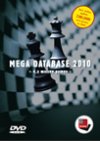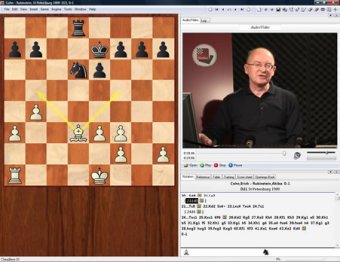 |
ChessBase Reviews |
Last updated 18 January 2010

| index |
CDs, DVDs, Software Part 40

The Grünfeld Defence By Lubomir Ftacnik
The Grünfeld Defence (1.d4 Nf6 2.c4 g6 3.Nc3 d5) enjoys a special star status in the family of Indian openings. It involves a daring, active concept: fighting for control of the centre with an early d7-d5 thrust supported only by pieces. The ensuing lines and positions promise more active play than most openings. Black has to know the critical ideas and most promising plans as most lines are pretty sharp and concrete.

Many top players have tried to refute the Grünfeld, honourably failed and ended up defending its charms with remarkable success. The opening is fully covered in 50 sections covering all lines of any importance. Two bonus sections discuss typical endgames - Black usually has equal or superior chances in Grünfeld endings - as well as characteristic middlegame pawn structures.
The DVD presents a repertoire - for each variation, the author shows the best or most promising line for an amateur or tournament player. The games database gives the chance to understand more than 8000 Grünfeld games played by the best players - 1300 of them deeply annotated. The majority of the notes are by Krasenkow and Ftacnik who have dilligently covered the opening in ChessBase Magazine for two decades. Video running time: 7 hours 21 min.
Lubomir Ftacnik is a Slovak grandmaster with decades of experience in international chess. As a younger member of a strong chess generation in the former Czechoslovakia he helped to win silver at the Luzern Chess Olympiad in 1982. Most of his fellow grandmasters have been keen defenders of the Grünfeld Defence and the author has come up with his share of ideas in various lines. The work on the Grünfeld DVD is the fruit of 30 years experience with this active and rewarding opening.
With 3854 games in the database this DVD covers probably everything you would want to know about the Grünfeld Defence. The following is just one example of many of the authors games to be found on the DVD:
Delemarre,Jop (2235) - Ftacnik,Lubomir (2605) [D85]
Sonnevanck 5th Wijk aan Zee (7), 1995
[Ftacnik]
1.d4 Nf6 2.c4 g6 3.Nc3 d5 4.cxd5 Nxd5 5.e4 Nxc3 6.bxc3 Bg7 7.Nf3 c5 8.Rb1 0–0 9.Be2 Nc6 10.d5 Ne5 11.Nxe5 Bxe5 12.Qd2 b6 13.0–0 Bg7 14.f4 e6
15.d6 e5 16.Bc4 Be6 17.Bb5 [17.Bxe6 fxe6 18.Qd3 Qd7 19.Be3 Rad8 20.Rbd1 Rf7 (20...Qc6 21.c4 Rf7 22.fxe5 Rxf1+ 23.Rxf1 Bxe5 24.Bh6
Gomez Esteban,J-Sion Castro,M/Leon (06)/1994/1–0 (33)) 21.fxe5 Rxf1+ 22.Qxf1 Bxe5 23.Bg5 Rf8 24.Qd3 Van Wely,L-Yermolinsky,A/New York PCA-op
(07)/1994/0.5 (42)] 17...exf4 18.Qd3? [18.Qxf4 Bxc3 19.Bb2 Bxb2 20.Rxb2 f6 21.Rd1 with compensation] 18...c4! 19.Qd1 [19.Bxc4 Bxc4 20.Qxc4 Qxd6
21.Bxf4 Qe7-/+] 19...Qg5! [19...Bxc3 20.Bxf4-/+] 20.Ba3 [20.Bxf4 Qc5+ 21.Kh1 a6 22.Ba4 b5 23.Bc2 Bxc3 24.Qf3 Be5–+] 20...Rfd8 [20...Bxc3
21.Rc1 Be5 (21...Qxb5 22.Rxc3-/+) 22.Bxc4=/+] 21.Qd2 Be5 22.g3 [22.d7 Rxd7 (22...a6 23.Bc6 Rab8 24.Bd6 Bxd7 25.Bxe5 Qxe5 26.Bxd7 Rb7 27.Qxf4 Qxf4
28.Rxf4 Rdxd7 29.Rf6 with counterplay) 23.Bxd7 Rd8-/+] 22...Rxd6! [22...f6 23.Rxf4 Bxf4 24.Qxf4 Qe5-/+] 23.Bxd6 Rd8 24.Qg2 [24.Kh1 Rxd6 25.Qc1 Bh3
26.Rf2 Qg4 27.gxf4 Bxf4!–+; 24.Bd7!! Rxd7 25.Rb5 Bxc3! (25...f6 26.Rd5 Bxd5 27.Qxd5+ Kg7 (27...Kh8?? 28.Qa8+ Kg7 29.Qf8#) 28.Bf8+ Kxf8 29.Qxd7 fxg3
30.Qd8+ Kg7 31.Qd7+ Kh6 32.Qh3+ Qh5 33.Qxh5+ Kxh5-/+) 26.Rxg5 Bxd2 27.Bxf4 c3–+] 24...f3! [24...Rxd6 25.gxf4 Qxg2+ (25...Bxf4 26.Qxg5 Bxg5
27.Rbd1 idea Bd2 28.Rf2!) 26.Kxg2 Bxc3-/+] 25.Qxf3 [25.Rxf3 Rxd6 26.Rbf1 Bxc3 27.Rxc3 Qxb5-/+] 25...Rxd6 26.Kh1 [26.Rbd1 Rxd1 27.Qxd1 (27.Rxd1 Bg4
28.Rd8+ Kg7–+) 27...Qe3+ 28.Rf2 Bxc3–+] 26...Rd3 27.Qg2 Qh5! 28.Rg1 [28.g4 Qh4 29.Rbd1 Rh3–+; 28.Kg1 Bxc3–+] 28...Rxg3 [28...Rxg3 29.Qf2 Rxc3–+] 0–1
System requirements: Pentium-Processor at 300 Mhz or higher, 64 MB RAM, Windows XP, Windows Vista, DVD drive, mouse, soundcard.

Mega Database 2010 By ChessBase
It's that time of year again when Chessbase roll out what I consider to be one of their flagship products. In my humble opinion this is the best database available on the market.
The exclusive annotated database. Contains more than 4.5 million games from 1560 to 2009 in the highest ChessBase quality standard. 65,000 games contain commentary from top players, with ChessBase opening classification with more than 100,000 key positions, direct access to players, tournaments, middlegame themes, endgames. The largest top class annotated database in the world.
The most recent games of the database are from the middle of November 2009. Mega 2010 also features a new edition of the playerbase. As usual, this is where most of the work was done. As the player index now contains already more than 240,000 entries, it made sense to use an adapted playerbase which includes about 258,000 names. Doing this, the photo database was extended as well to contain 31,000 pictures now.
With ChessBase 10 you can download games for Mega 2010 for the whole year, a total of approximately 200,000! That means your Mega 2010 will remain up to date from January to December.
The following two DVDs are separate products but work well together to provide a well grounded set of lessons to improve your overall chess abilities.

Power of Exchange By Adrian Mikhalchishin

Adrian Mikhalchishin, a Grandmaster since 1978, is currently among the top 5 world trainers and the Chairman of the FIDE Trainers’ Commission. He trained the team of USSR in 1980s, national teams of Slovenia, Poland and the Netherlands, and was the trainer of Anatoly Karpov (1980-1986), trained Zsuzsa Polgar, Alexander Beliavsky, Maja Chiburdanidze, Arkadij Naiditsch and Vassily Ivanchuk.
The correct technique of exchanging is the most important ability of Grandmasters! Which pieces to swap and which pieces to keep, whether to recapture with a piece or with a pawn, these are questions which every player of every level has to answer many times during a single game. And the greatest difference between GMs and amateurs is not in opening knowledge or in calculation power, but in this simple technique.
The great Botvinnik even said that chess is just multiple exchanges. He explained Fischer’s technique of play: He had never bad pieces - he always exchanged them for his opponent’s strong pieces. Video running time: 3 hrs.

Power of Planning By Adrian Mikhalchishin

Planning is the most difficult part of the game of chess. It is everywhere - we use it from the opening to the ending.
A plan is based on evaluation and that evaluation is based on the different static and dynamic elements of the position. But what the chess books don’t describe is the direction of the plan.
The aim of every plan is the exploitation of weakness! So, spot the weakness, fix it and then just attack it. There are different kinds of plans - typical plans, based on the structures and analogical plans, based on similar constellations of the pieces on the board.
The subject is really big, but the author wanted to show examples of how to construct plans in positions with pawn majorities on the flanks and to teach you how to exploit this element properly. Video running time: 3 hrs 19 min.

Powerbook 2010 By ChessBase

The current openings theory with 1.6 million games. The Fritz Powerbook 2010 contains 27 million opening positions, derived from 1.6 million high class tournament games.
Together with each position all relevant information is stored: all moves that were played in the position, by players of what average rating, with what success and performance results.
The games from which the Fritz Powerbook 2010 were derived are also included on the DVD. This means that in any position of the openings tree you can load and replay the games in which the position occurred.
The Fritz Powerbook 2010 represents the state of the art of current openings theory. Discover exciting and tricky new lines and practice them against Fritz.
In addition the DVD has a small but very exclusive book with the strongest GM games (ELO >= 2550) from the past 100 years (1.8m positions).

PowerPlay 11 - Defence By Daniel King
Daniel King’s PowerPlay DVD series is one of the most successful and informative chess instruction tools available today. The latest – Powerplay 11 – Defence – is no exception.

There is a seeming inevitability to many defeats – one side has the initiative, goes on the attack and from that moment it is very difficult to turn back the tide. In this 11th Power Play DVD Grandmaster Daniel King will help you to identify those key moments where there is potential danger. The secret to good defensive play is to avoid falling into a passive defensive position!
Throughout the DVD, specially selected positions enable you to test your understanding of the subject. The Power Play series is suitable for anyone looking to improve their chess, but also provides ready-made lessons and exercises for a trainer. Video running time: 5 h 25 min.
Grandmaster Daniel King has been a professional chess player for more than 20 years. During that time he has represented his country on many occasions, including an historic match victory over the Soviet Union in Reykjavik, 1990. At the same time he has distinguished himself as a coach, helping many of England‘s younger generation to achieve their potential. Besides his chess career, he has built up a reputation as a commentator on television, radio and the internet. He is also an award-winning author of more than 15 books.

The Trompowski the Easy Way (2nd Edition) By Andrew Martin
I know quite a few of our players who will enjoy this DVD. The Trompowski seems to be quite popular these days with some of our top players. Those of you who don’t use it should still try to get a copy of this one as you are bound to face it at some point in our tournaments.

As usual Andrew Martin gives a first class presentation and you will end up with a thorough understanding of the opening.
Thirty years ago the Trompowsky opening was almost totally unknown. It took a few spectacular games by Rafael Vaganian to bring 2.Bg5 into the limelight, and after that, the die was cast. Today 1.d4 Nf6 2.Bg5 is used by many of the best players in the world and a whole body of complicated theory has built up.
In this fascinating DVD, International Master Andrew Martin traces the history of the opening from those early days, through the "golden age" of the late 1980s and 1990s, and shows how the theory and ideas have evolved into the sharp and dangerous weapon that the Trompowsky undoubtedly is today. Martin simplifies the theory of 2009 and creates an easy-to understand repertoire for the White player that recaptures the pioneering spirit of those early days ... with interest! He argues conclusively that 2.Bg5 can still lead to original chess. Games from Vaganian, Hodgson, Bellon, Miladanovic, McShane, Ivanchuk and a whole cast of excellent players help to demonstrate why. Video running time: 4 hours.
Andrew Martin is 52 years old and lives in Yateley, England. He is an International Master and noted chess trainer. He is also the Manager of Coaching for the English Chess Federation.

1.e4 Repertoire By Sam Collins
Grandmaster lines explained for club players – constructing an opening repertoire is one of the chess player’s most difficult and time-consuming tasks. Turned off by masses of theory, many players shy away from critical lines and concentrate on trappy lines, "universal" systems, or variations which concede the advantage of the first move in order to get a playable position.

In this DVD, Sam Collins offers another way. Discussing sound, aggressive lines, all with regular top-level support from GMs Tiviakov, Howell, Pavasovic and others, Collins breaks down each position into its key components and explains the core plans and ideas, together with enough theory to avoid any accidents and catch your opponents by surprise. With over 8 hours of top-class instruction, he helps lay the foundation for a repertoire to last for your whole chess career.
The repertoire contains e.g. following recommendations:
- 2. c3 against the Sicilian,
- Italian 4.c3 (5.d3) against Open Game,
- Tarrasch against the French,
- Panov Attack against the Caro-Kann,
All in all 52 (!) lessons and about 8 hours video running time.
Sam Collins is an International Master from Ireland who made a GM norm in 2008. He has represented his country at five Olympiads, winning a gold medal at Bled in 2002. He is the author of several best selling opening books and is a regular columnist in chess periodicals.
As a coach, he has lectured national junior squads and taught the master class at the renowned Berkeley Chess School. He is a former Irish champion and the reigning champion of Japan.
This is a good all round DVD.